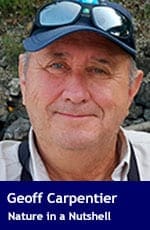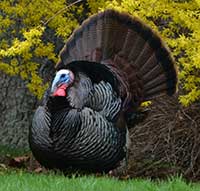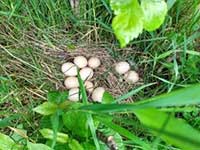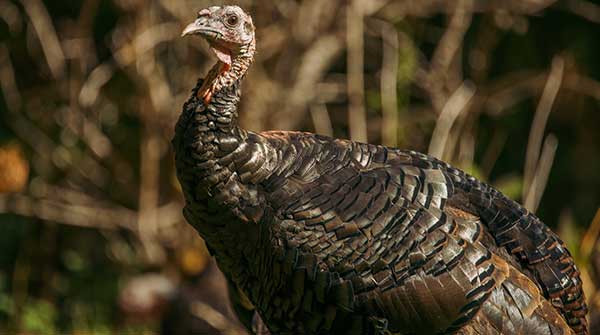Did you know Benjamin Franklin wanted the turkey to be the U.S.’s National Bird?
 My wife and I have had the unique opportunity (at least to us) to share our yard with three families of wild turkeys this year.
My wife and I have had the unique opportunity (at least to us) to share our yard with three families of wild turkeys this year.
Birds of one brood often join with other broods after the young have hatched, and then the blended families move in loose flocks through their communal territory. In our case, that included our yard and the yards of at least six adjacent neighbours. The thrill of seeing 11 to 15 of these great birds daily this summer has been a delight to all of us.
When I started birdwatching about 60 years ago, Wild Turkeys, as they’re correctly known, were exceedingly rare in the east, particularly in Ontario. One had to go to the Thousand Islands area near Gananoque to find them.
So why are they so common today?
 Why are Wild Turkeys so common today? |
 Wild Turkey eggs |
| Related Stories |
| The astonishing sounds fish make
|
| Where do fish go in the winter?
|
| How to read animal tracks in the snow
|
Let’s step back for a minute. First of all, Wild Turkeys are native to Ontario and co-existed with Indigenous Peoples and settlers alike until the early 1900s, when overhunting and land clearing resulted in their extirpation from Ontario (i.e. extinction on a local level as they still persisted elsewhere in their historical range).
Starting in 1984, the then Ontario Ministry of Natural Resources initiated a program to reintroduce them into Ontario to provide a new game species for hunters. Initially, small flocks were brought from select U.S. locations and released in southwest Ontario. Once this was proven successful, subsequent release projects were initiated in Renfrew County, Ont. in 1997. After that, they did exceptionally well; today, over 70,000 birds range across much of Ontario.
Historically, Wild Turkeys were uncommon and occurred only in the dense mature forests of southwest Ontario, avoiding open and agricultural areas. The birds introduced in the 1980s came from different stock and were content to forage in forests, agricultural fields, and residential areas. Turkeys, in part due to their burgeoning numbers, damage the understory of forests because they scratch and scrape the soil over a large area looking for nuts, seeds or insects. The forest community that pre-existed them is not able to cope effectively.
They nest differentially depending on where they live. For example, southern U.S. populations can start the breeding cycle in January, but courtship in Canada doesn’t begin until late February or early March. After copulation, the female chooses a simple nest site, often in the forest near the base of a tree or out in an ungrazed pasture, sometimes near a small bush.
Up to 26 eggs can be laid in a single nest, but this is likely due to what is known as egg dumping, where more than one female lays her eggs in the same nest. Only the original nest owner usually will incubate the eggs, but two females might occasionally participate. This latter behaviour is not well documented.
At the beginning of the egg-laying cycle, the female lays her first egg, followed by the second egg two days later. From the fourth egg onward, she lays the remaining eggs on consecutive days, starting incubation around the time the last egg is laid. The female solely handles the nest building and caring for the young, while the males might stay close, hoping for another opportunity to mate if the first nest fails.
Food consists mainly of nuts, berries and seeds from various plants, but a small portion (about 10 percent) is comprised of insects and small cold-blooded vertebrates such as salamanders. Feeding is accomplished in various ways but typically involves scratching and clawing at the soil to expose nuts and insects in the leaf litter.
One unique behaviour my wife and I have witnessed in our yard is the side-by-side march of a flock of birds through a short grass meadow, basically flushing prey such as crickets and grasshoppers. The dominant female leads this hunting party as it advances across the field.
One final note: Benjamin Franklin proposed the turkey as the National Bird of the U.S., but the Bald Eagle won out. Seems like a good choice!
Geoff Carpentier is a published author, expedition guide and environmental consultant.
For interview requests, click here.
The opinions expressed by our columnists and contributors are theirs alone and do not inherently or expressly reflect the views of our publication.
© Troy Media
Troy Media is an editorial content provider to media outlets and its own hosted community news outlets across Canada.

